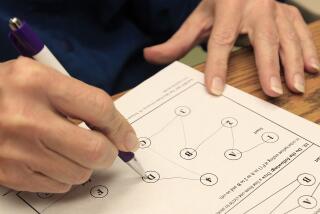Detecting concussions
- Share via
Athletes often try to shake off collisions with other players so that they can get back to the game. But, if they’ve been hit in the head, a return can be dangerous.
Collisions on the playing field can slam the brain against the skull or shear nerve fibers on the brain stem. These injuries can cause concussions, leading to bleeding and swelling inside the brain. If an athlete sustains even a mild concussion, another blow to the head could lead to permanent disability or even death.
Although these injuries are difficult to diagnose (current screening tools aren’t reliable), an experimental device may eventually help coaches evaluate head injuries in just a few minutes.
“This could be an exciting tool because what you don’t want is to send someone back into play if they have had a concussion -- even a mild one,” says Dr. Alex Valadka, a neurosurgeon at Baylor College of Medicine in Houston and a spokesman for the American Assn. of Neurological Surgeons.
More than 300,000 Americans suffer brain injuries on playing fields each year. In any given season, 1 in 5 high school football players and 10% of college players sustain concussions, according to the American Assn. of Neurological Surgeons. Ice hockey players, wrestlers and baseball and softball players also have high rates of head injuries.
Because symptoms of concussion can be mild -- dizziness, temporary confusion or a sense of feeling “dinged” that lasts less than 15 minutes -- they are often undetected, which can be insidious because the brain becomes more vulnerable to repeated hits.
And when an athlete doesn’t fully recover from a concussion and then experiences another hit within a week or two, second-impact syndrome may occur, a rare and often-fatal condition caused by rapid cerebral swelling. Even if the injuries aren’t life threatening, their cumulative effects can impair mental functioning.
Many coaches and trainers evaluate an athlete’s mental status with a five-minute series of questions and physical exercises known as the standardized assessment of concussion. “But the SAC test isn’t comprehensive enough to pick up the variety of mental deficits that occur from a mild brain injury, and some injuries can be missed,” says Michelle LaPlaca, a biomedical engineer at Georgia Institute of Technology in Atlanta and a co-inventor of the new device.
The Display Enhanced Test for Concussions and Mild Traumatic Brain Injury System, or DETECT, was designed to be a more sensitive screening tool. The computerized device, which can be used on the sidelines, consists of a pair of wraparound goggles that fit snugly over the face, and large plastic headphones to shut out noise and other distractions.
An LCD display in the headgear guides the wearer through three types of neuropsychological tests that measure brain function; voice instructions are given through the headphones. Athletes use a hand-held device similar to a video game controller to respond. The device measures the wearer’s response times and gauges answer selections.
“This tests executive functioning -- are all the brain’s connections intact and are they doing what they’re supposed to be doing -- and it also tracks how fast players respond,” says Dr. David Wright, an emergency room physician at Emory University in Atlanta and a co-inventor of the device. If response time is too slow or the answers are incorrect, the athletes may need further tests.
The device has been used by 42 healthy volunteers in the lab, and tested on 35 patients in the early stages of Alzheimer’s disease to determine if it could detect these deficits. Although final test results aren’t available, Wright said the device picked up clear differences between the impaired group and the healthy volunteers.
This fall, researchers plan to do more tests on the Georgia Tech football team. If all goes well, Wright says, the device could become a standard tool on the nation’s playing fields within two to three years.
*
(BEGIN TEXT OF INFOBOX)
Grading the severity
Concussions have different levels of severity, according to guidelines from the American Academy of Neurology.
Grade 1 is considered mild, and is characterized by confusion, no loss of consciousness and a sense of feeling “dinged.” Symptoms disappear in less than 15 minutes.
Grade 2 is a moderate concussion. Symptoms include confusion and amnesia that last more than 15 minutes.
Grade 3 is a severe concussion, in which a person experiences a loss of consciousness, even if it’s only for a few seconds.
More to Read
Go beyond the scoreboard
Get the latest on L.A.'s teams in the daily Sports Report newsletter.
You may occasionally receive promotional content from the Los Angeles Times.










